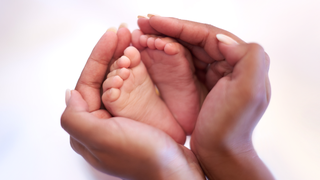Going past your due date
It’s usually safe to go up to a week past your due date — from 40 to 41 weeks. But once you reach 41 weeks, the risks, whilst still very small, do start to increase. These include:
- needing a caesarean birth
- your baby needing care in a neonatal unit
- stillbirth and neonatal death
If you have gone past your due date, your care providers will be there to support you. They’ll talk through the best options with you, which might include extra monitoring or an induction.
Induced labour
Around 1 in 5 births are induced, which means that drugs are used to get the labour going.
You might be offered a membrane sweep first – this can feel uncomfortable, but it does not harm you or the baby.
A drug called prostaglandin is then used to open up the cervix and get contractions going. It's put into the vagina as a gel or tablet.
It can also be delivered through a pessary, which looks like a mini tampon and releases the drug over 24 hours.
You may need to have your waters broken if they do not break naturally. You may also be offered a drip containing another drug called syntocinon if the labour needs to be speeded up.
There's a lot to consider when you're offered an induction, so ask as many questions as you like.
Here are a few things to consider:
- there could be medical reasons why it's important for your baby to be delivered sooner rather than later
- induction can often avoid the need for a caesarean
- it could be more painful than a spontaneous delivery – you may end up with an assisted delivery using forceps (which are a bit like tongs) or a ventouse (which is a special suction cup)
Read more about your options for giving birth over 40 weeks.
RSV vaccination
Have you had the RSV (respiratory syncytial virus) vaccine? It's usually offered at around week 28 but can be given later if needed, right up until you go into labour.
Having the vaccination can lower your baby's risk of a severe lung infection called bronchiolitis, which can make it difficult for your baby to breathe and feed. If you've not had it yet, speak to your midwife or a GP.
3rd trimester pregnancy symptoms (at 41 weeks or more)
You could be feeling very frustrated, but try to stay calm as that's best for you and the baby.
Your signs of pregnancy could also include:
- painless contractions around your bump, known as Braxton Hicks contractions
- sleeping problems (week 19 has information about feeling tired)
- stretch marks (week 17 has information on stretch marks)
- swollen and bleeding gums (week 13 has information on gum health during pregnancy)
- pains on the side of your baby bump, caused by your expanding womb ("round ligament pains")
- piles (week 22 has information on piles)
- headaches (read about headaches in pregnancy on NHS.uk)
- backache
- indigestion and heartburn (week 25 has information on digestive problems)
- bloating and constipation (week 10 has information on bloating)
- leg cramps (week 20 has information on how to deal with cramp)
- feeling hot
- dizziness
- swollen hands and feet
- urine infections
- vaginal infections (week 15 has information on vaginal health)
- darkened skin on your face or brown patches – this is known as chloasma or the "mask of pregnancy"
- greasier, spotty skin
- thicker and shinier hair
You may also experience symptoms from earlier weeks, such as:
- mood swings (week 8 has information on mood swings)
- morning sickness (week 6 has information on dealing with morning sickness)
- weird pregnancy cravings (week 5 has information on pregnancy cravings)
- a heightened sense of smell
- sore or leaky breasts (week 14 has information on breast pain) – a white milky pregnancy discharge from your vagina and light spotting (seek medical advice for any bleeding)
What does my baby look like?
The average baby is now around 3 to 4kg. We cannot be too precise, but imagine that there's a small pumpkin or a watermelon sitting in your stomach.
The fast period of growth is now over. Your baby should be chubby enough and mature enough to survive outside the uterus (womb) without any assistance.
Overdue babies tend to have red, dry and peeling skin. This is usually because they've lost their vernix, which is the greasy layer that stops their skin from drying out in the amniotic fluid.
Don't be tempted to moisturise your baby's rough skin, as it could make it even worse. The red layer will peel off after a few days, without any help, revealing perfect skin underneath.

Action stations

Baby basics
From the essentials of caring for your baby to understanding their sleep, find out all the baby basics you need to know about your newborn.
